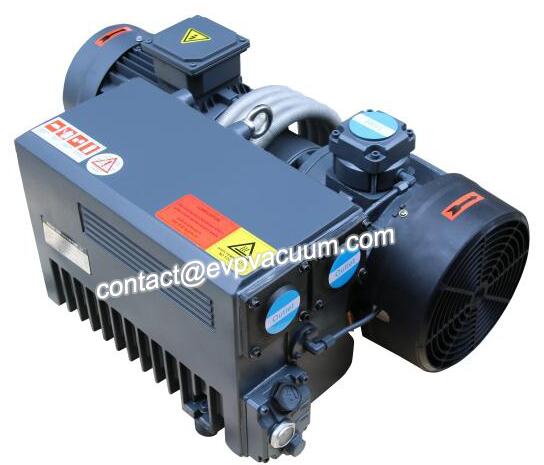Rotary vane vacuum pump structure
The rotary vane vacuum pump is mainly composed of stator, rotor, rotary vane, fixed cover, spring and other parts. The structure of rotary vane vacuum pump is composed of two rotating vanes which are mounted eccentrically in the stator cavity (the clearance between the outer circle of the rotor and the inner surface of the stator is very small) and sliding in the rotor slot, which are attached to the inner wall of the stator by spring tension and centrifugal force. When the rotor rotates, it always slides along the inner wall of the stator. Rotary vane vacuum pump is the basic equipment used to extract gas from sealed container and obtain vacuum.
rotary vane vacuum pump working principle:
There are more than two rotary blades in the rotor groove. Springs are installed between the rotary blades of these pumps. The rotor is eccentrically mounted in the pump chamber, and there is a small gap between the outer edge and the top of the pump chamber, which is about 2-3 microns. When the rotor rotates, under the action of centrifugal force and spring, the top of the rotary vane slides back and forth along the groove and keeps contact with the inner wall of the pump chamber, dividing the pump chamber into two or several variable volume workshops. When the rotor rotates clockwise, the volume of the suction chamber increases gradually with the inhalation of air, and the pressure of the gas in the chamber decreases with the continuous inhalation of air. At the same time, the volume of the exhaust chamber decreases from large to small, and the gas in the inhalation chamber is compressed. When the gas pressure is higher than one atmospheric pressure, the exhaust valve gas is pushed open and discharged through the oil reservoir in the tank. The rotor rotates continuously, the pump pumps continuously and then exhausts. There are two kinds of rotary vane pumps: single-stage and double-stage. If the exhausted gas passes through the airway and transfers to another low vacuum stage, it is pumped out by the low vacuum stage, and then compressed by the low vacuum stage and discharged into the atmosphere, the two-stage pump is formed. This two-stage pump can improve the ultimate vacuum, because the total compression ratio is shared by two stages.
Rotary vane vacuum pumps are mostly small and medium-sized pumps with low working pressure and belong to low vacuum pumps. It can be used independently or as the front pump of various pumps, such as booster pump, diffusion pump or high vacuum pump. Because of its small size, easy start-up, low noise and light weight, it has been widely used in machinery, metallurgy, chemical industry, military industry, light industry, petroleum, electronics and medicine industries.
Now with the development of technology and the improvement of manufacturing technology, the rotary shaft of rotary vane vacuum pump can be directly connected with the motor shaft, which can improve the pumping rate and reduce the weight of the pump.
Rotary vane vacuum pump can only pump dry gas or gas containing a small amount of condensable steam, but it must be equipped with air ballast valve. Other gases with corrosive, explosive, solid particles and chemical effects on the pump oil itself should not be removed.
(The article comes from the Internet. If reprinting is not allowed, please contact our company to delete it.)

